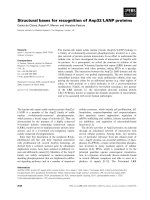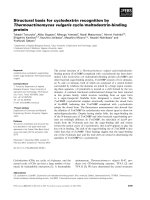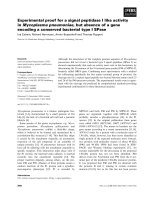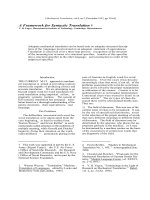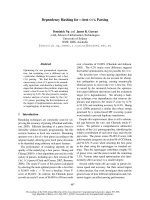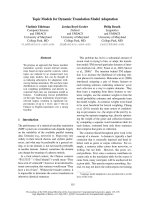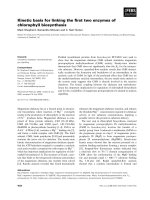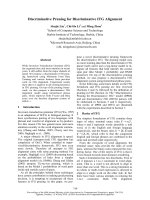báo cáo khoa học: " Overdose prevention for injection drug users: Lessons learned from naloxone training and distribution programs in New York City" pdf
Bạn đang xem bản rút gọn của tài liệu. Xem và tải ngay bản đầy đủ của tài liệu tại đây (784.84 KB, 8 trang )
BioMed Central
Page 1 of 8
(page number not for citation purposes)
Harm Reduction Journal
Open Access
Research
Overdose prevention for injection drug users: Lessons learned from
naloxone training and distribution programs in New York City
Tinka Markham Piper
1
, Sasha Rudenstine
1
, Sharon Stancliff
2
,
Susan Sherman
3
, Vijay Nandi
1
, Allan Clear
2
and Sandro Galea*
4
Address:
1
Center for Urban Epidemiologic Studies, New York Academy of Medicine, New York, NY 10029, USA,
2
Harm Reduction Coalition, New
York, NY 10001, USA,
3
Department of Epidemiology, Johns Hopkins Bloomberg School of Public Health, Baltimore MD 21205, USA and
4
Department of Epidemiology, University of Michigan School of Public Health, Ann Arbor, MI 48104, USA
Email: Tinka Markham Piper - ; Sasha Rudenstine - ; Sharon Stancliff - ;
Susan Sherman - ; Vijay Nandi - ; Allan Clear - ;
Sandro Galea* -
* Corresponding author
Abstract
Background: Fatal heroin overdose is a significant cause of mortality for injection drug users
(IDUs). Many of these deaths are preventable because opiate overdoses can be quickly and safely
reversed through the injection of Naloxone [brand name Narcan], a prescription drug used to
revive persons who have overdosed on heroin or other opioids. Currently, in several cities in the
United States, drug users are being trained in naloxone administration and given naloxone for
immediate and successful reversals of opiate overdoses. There has been very little formal
description of the challenges faced in the development and implementation of large-scale IDU
naloxone administration training and distribution programs and the lessons learned during this
process.
Methods: During a one year period, over 1,000 participants were trained in SKOOP (Skills and
Knowledge on Opiate Prevention) and received a prescription for naloxone by a medical doctor
on site at a syringe exchange program (SEP) in New York City. Participants in SKOOP were over
the age of 18, current participants of SEPs, and current or former drug users. We present details
about program design and lessons learned during the development and implementation of SKOOP.
Lessons learned described in the manuscript are collectively articulated by the evaluators and
implementers of the project.
Results: There were six primary challenges and lessons learned in developing, implementing, and
evaluating SKOOP. These include a) political climate surrounding naloxone distribution; b) extant
prescription drug laws; c) initial low levels of recruitment into the program; d) development of
participant appropriate training methodology; e) challenges in the design of a suitable formal
evaluation; and f) evolution of program response to naloxone.
Conclusion: Other naloxone distribution programs may anticipate similar challenges to SKOOP
and we identify mechanisms to address them. Strategies include being flexible in program planning
and implementation, developing evaluation instruments for feasibility and simplicity, and responding
to and incorporating feedback from participants.
Published: 25 January 2007
Harm Reduction Journal 2007, 4:3 doi:10.1186/1477-7517-4-3
Received: 22 September 2006
Accepted: 25 January 2007
This article is available from: />© 2007 Piper et al; licensee BioMed Central Ltd.
This is an Open Access article distributed under the terms of the Creative Commons Attribution License ( />),
which permits unrestricted use, distribution, and reproduction in any medium, provided the original work is properly cited.
Harm Reduction Journal 2007, 4:3 />Page 2 of 8
(page number not for citation purposes)
Background
Fatal heroin overdose is a significant cause of mortality for
injection drug users (IDUs) [1,2]. Half of all heroin drug
users report at least one nonfatal overdose during their
lifetime [3-5]. In New York City (NYC), an estimated 900
opiate users die from overdose each year, a figure that
exceeds the number of deaths from homicide [6,7]. Many
of these deaths are preventable because opiate overdoses
can be quickly and safely reversed through the injection of
Naloxone [brand name narcan], a prescription drug used
to revive someone who has overdosed on heroin or other
opioids. In addition, most overdoses occur in the presence
of others, often drug-using peers [1,8] and many deaths
may occur due to bystander response, mainly the reluc-
tance of peers to contact emergency medical services for
fear of police involvement [3].
Naloxone, an opiate antagonist, has long been adminis-
tered by doctors and paramedics during emergency resus-
citation after an opiate overdose. However, the provision
and use of naloxone by drug users is a new and innovative
approach to reducing opiate-related mortality. Currently,
in several cities in the United States (US), drug users are
being trained in naloxone administration and given
naloxone for immediate reversals of opiate overdoses [9-
13]. Preliminary reports from these programs have docu-
mented lifesaving events through peer administration
without observed adverse effects [11,12,14] and increased
overdose awareness and preparedness among opiate users
in the programs. While the prevalence of opiate overdose
mortality and the role of naloxone in opiate overdose pre-
vention are gaining increased public health-related atten-
tion, there has been limited formal description of the
development, implementation and evaluation of a large-
scale naloxone administration training and distribution
programs to IDUs and the lessons learned during this
process [12,15].
In 2004, a pilot overdose prevention project at two NYC
Syringe Exchange Programs (SEPs) trained approximately
100 drug users on overdose prevention. In 2005, the
Harm Reduction Coalition (HRC), a national organiza-
tion that uses education, interventions and community
organizing to reduce drug-related morbidity and mortal-
ity, started the Skills and Knowledge on Overdose Preven-
tion Project (SKOOP) [16]. SKOOP had three main goals:
(i) to reduce overdose-related deaths through the distribu-
tion of naloxone hydrochloride to injection drug users in
NYC; (ii) to build evidence for the effectiveness of take-
home naloxone in harm reduction settings, and (iii) to
create wider support for the inclusion of naloxone in
harm reduction, methadone, and other public health pro-
grams.
The NYC HRC, NYC SEPs, the New York Academy of Med-
icine, and the Johns Hopkins Bloomberg School of Public
Health collaborated on program design, implementation
and evaluation of SKOOP at NYC SEPs. In this manu-
script, the collaborators will discuss challenges and les-
sons learned from the implementation of SKOOP and
offer recommendations for other SEPs that are consider-
ing the distribution of naloxone to drug users as a health
promotion and disease prevention initiative.
Methods
Program design
Between March 2005 and March 2006, 1004 IDUs were
trained in overdose prevention and given a prescription
for naloxone. Participants were over the age of 18, current
participants of NYC SEPs, and current or former drug
users. Outreach efforts to recruit participants into the pro-
gram, included flyers, word of mouth, enlistment during
syringe exchange sessions and through other educational
and medical programs. Figure 1 and Figure 2 show exam-
ples of recruitment flyers used in the program.
Overdose prevention and reversal curriculum
All participants received an overdose prevention training
by SEP staff who were trained by the onsite medical direc-
tor and physician. The overdose training course, SKOOP,
was modeled after existing naloxone distribution pro-
grams in Chicago and San Francisco [10,17] and is availa-
ble from the authors. Opiate users were trained either
individually, in pairs, or in small groups (5–15 people) by
SEP and HRC staff. Each SKOOP training ranged from 10–
30 minutes. The SKOOP curriculum focused on overdose
prevention education and naloxone administration.
Overdose prevention training included teaching and dis-
cussing (a) the causes of opiate overdose (i.e. loss of toler-
ance, mixing drugs, physical health and variation in
strength of 'street drugs'), (b) how to avoid an opiate over-
dose (i.e. know your tolerance and supply, control your
high, injection techniques, aware of risks of mixing drugs,
and minimize using alone), and (c) signs of an opiate
overdose. The naloxone training included information on
naloxone, education about appropriate responses to opi-
ate overdose (i.e. calling 911 and performing rescue
breathing) and instructions on naloxone administration
(intramuscular injection practices, the use of naloxone
only with opiate-related overdose and the potential need
for a second dose of naloxone). In some trainings, a rescue
dummy was available to demonstrate and practice rescue
breathing procedures; in all trainings, the correct use of a
rescue breathing mask was modeled to participants. SEP
trainers also discussed methods of cooperating with
police and medical staff post-naloxone administration
and the importance of talking to drug using partners
about naloxone and overdose response.
Harm Reduction Journal 2007, 4:3 />Page 3 of 8
(page number not for citation purposes)
Naloxone kit and naloxone prescriptions
Upon successful completion of the overdose prevention
training, participants in the program met with an on-site
physician for a brief (1–2 minutes), targeted medical his-
tory who then gave each participant a "naloxone kit," a
carrying case with the following contents: two doses of
naloxone in pre-filled syringes (1 mg/ml), a rescue breath-
ing mask, and written information summarizing overdose
revival steps. A prescription was also give as proof of the
legitimacy of the medication. The medical history was
also an opportunity for the medical doctor to inquire if
participants needed referrals for primary care or drug
treatment and to ensure that the participant understood
the material delivered during the SKOOP training. Refills
were given as needed by the medical doctor. Figure 3 con-
tains a picture of the contents of the naloxone kit.
Results and Discussion
Challenges and Lessons Learned
We will describe here both challenges and lessons learned
from SKOOP and conclude with recommendations for
future naloxone distribution programs. These insights are
collectively articulated, discussed and summarized by
both the evaluators and implementers on the project. This
diverse team included the medical director on site at the
SEPs who provided SKOOP training for SEP staff, pre-
scriptions and medical histories for participants, and liai-
son with the external evaluators; external evaluators (both
quantitative and qualitative-focused) who assisted with
study and survey design and implementation; project
managers who trained and supervised survey interviewers
and coordinated the overall programmatic efforts; and the
administrator at Harm Reduction Coalition who had
Recruitment flyer used in SKOOP program by staff at Syringe Exchange Programs in New York CityFigure 1
Recruitment flyer used in SKOOP program by staff at Syringe Exchange Programs in New York City.
Harm Reduction Journal 2007, 4:3 />Page 4 of 8
(page number not for citation purposes)
overall responsibility for project implementation.
Together, the team identified six primary challenges and
lessons learned from SKOOP, including: a) political cli-
mate of naloxone distribution b) extant prescription drug
laws; c) initial low levels of recruitment into the program;
d) training methodology modifications; e) conducting a
formal evaluation; and f) evolution of program response
to naloxone.
a. Political climate of naloxone distribution
Proponents of naloxone administration programs define
opiate overdose as a health promotion, disease preven-
tion, and harm reduction issue. Opponents see naloxone
administration programs as vehicles to encourage drug
use among opiate users who will view naloxone as an
"escape valve" or "safety net" and an opportunity to
increase their drug use issue [12,18]. For these reasons,
naloxone provision to drug users is a politically charged
issue. Changes in the New York State legislature regarding
overdose prevention coupled with a growing awareness of
overdose prevalence mortality assisted the program's fea-
sibility. In April 2006, a New York State law regarding opi-
oid overdose prevention now authorizes the state health
commissioner to establish standards for overdose preven-
tion programs and the use of naloxone by non-medical
staff in the case of an overdose [19]. This law was unani-
mously passed in the House and Senate and supported by
the Medical Society of the State of New York.
Overdose prevention is attractive to many agencies that
provide services to drug users and yet have not chosen to
furnish syringes for their clients. Therefore, the SKOOP
project has been educating many agencies including drug
treatment providers, housing agencies and primary care
Recruitment flyer used in SKOOP program by staff at Syringe Exchange Programs in New York CityFigure 2
Recruitment flyer used in SKOOP program by staff at Syringe Exchange Programs in New York City.
Harm Reduction Journal 2007, 4:3 />Page 5 of 8
(page number not for citation purposes)
providers on overdose prevention and naloxone adminis-
tration. Two methadone providers and one primary care
unit are preparing to start providing naloxone, and a
dozen other agencies are actively interested in providing
these services [20]. Overdose is increasingly becoming rec-
ognized as a serious public health issue and naloxone is
increasingly seen as a new and innovative approach to
reducing opiate-related mortality.
b) Extant prescription drug laws
In most states, and until recently in New York, it was ille-
gal for someone with a prescription medicine to adminis-
ter it to someone for whom it was not prescribed. This, for
example, would apply to naloxone (for a drug-using part-
ner or an unknown overdosing person) or an extra dose of
Azithromycin (for the unseen partner of a patient being
treated for Chlamydia). The recent New York State opioid
overdose prevention law (April 2006) that allows for non-
medical persons to administer naloxone has facilitated an
opportunity for a range of organizations to implement
overdose prevention programs. New Mexico has similar
legislation [21] and Connecticut's law allows for licensed
health care practitioners to prescribe, dispense or admin-
ister naloxone to drug users to prevent overdose deaths
without civil or criminal liability [22]. However even in
those states, naloxone remains a prescription medication
with many states requiring a face-to-face encounter for a
medication to be legally prescribed. Current prescription
drug laws provide a challenge in finding and recruiting
medical physicians on naloxone distribution programs.
To facilitate and expedite medical involvement in the
project, SKOOP has created a brief targeted medical
record, accomplished in one minute for most SKOOP par-
ticipants, and the prescriber/medical physician does not
need to participate in the training. The SKOOP project is
also currently working with medical staff in contact with
The naloxone kit provided to participants in the SKOOP programFigure 3
The naloxone kit provided to participants in the SKOOP program. Photo credit: Harry Peronius
Harm Reduction Journal 2007, 4:3 />Page 6 of 8
(page number not for citation purposes)
drug users both at syringe exchanges and drug treatment
programs. In addition, pharmacies have begun to show
strong interest in stocking and providing naloxone [23].
c. Initial low levels of recruitment into the program
In the early months of the program, participants' miscon-
ceptions about naloxone were initially seen as a barrier.
Some participants who had negative perceptions of
naloxone from street lore or personal experience were ini-
tially unwilling to participate in the program [24]. Prima-
rily, participants were concerned with the dopesickness–
or opiate withdrawal characterized by shaking, headache,
nausea, and vomiting–associated with using naloxone.
SEP staff shifted to generalizing messages to increase pro-
gram involvement with a focus on "overdose prevention"
and "saving lives." Outreach methods and flyers were
modified to emphasize health promotion and overdose
prevention to encourage opiate users to partake in the
training and learn about the benefits of naloxone. Addi-
tional efforts to change perceptions included conducting
two focus groups among 13 participants to receive feed-
back about the program and better understand participant
experiences and views on naloxone [24].
d. Training methodology modifications
Prior to SKOOP, a pilot project with 25 IDUs was con-
ducted [11] and trainings were provided once a month
using a pair model, in which drug users were required to
present with a drug using partner as this allows for each
participant to theoretically be injected with their own
naloxone. Participants reported difficulties finding a
"pair" and coordinating schedules with their pair. It was
soon recognized that a lower threshold, "drop in"
approach, that targeted individuals was most appropriate
to facilitate participant needs. SKOOP learned from the
pilot experience and agencies have since developed many
models for the trainings and some employ multiple meth-
ods. Trainings may be in the storefront or conducted dur-
ing outreach. They may be one-on-one, or in groups and
can last between 10 and 30 minutes depending on the
needs of the group. While naloxone administration is a
life-saving intervention, it is also very simple to adminis-
ter. Some of the highest risk users may not have more than
10 minutes to spend in a training as they are trying to sus-
tain a heroin habit or may not have a long attention span
because they are under the influence of several drugs.
Trainings, therefore, were tailored to be quick, instructive
and tailored to the needs and time of each group. While
some participants were trained in drop-in settings, the
largest numbers of users were trained on street corners. To
illustrate this point, one day in February, the SEP training
team was set up at a new site in a warm room with coffee
and donuts. No one came. The team then reassembled in
a park near a methadone program and 26 participants
were trained. The process of selecting trainers changed in
some agencies during program implementation. Initially
many SEPs felt that senior staff needed to facilitate the
trainings which presented some conflict as these staff
members have responsibilities away from the front lines.
As knowledge and comfort with the program developed,
it became clear that outreach workers and peer educators
were not only capable of conducting the trainings, but
that their skills were well-suited to the tasks.
e. Conducting a formal evaluation
Achieving a balance between research/evaluation needs
and program/participant needs is an ongoing process that
requires effective management and communication,
including collaboration in the development of processes
for study design, implementation and dissemination of
findings. A pilot with 25 IDUs at a SEP in Lower Manhat-
tan was conducted in the early months of the program to
identify project feasibility [11]. Evaluation methods from
the pilot included a baseline and three month follow-up
instrument to assess prior overdose experience and
responses to witnessed overdoses, including naloxone
experience. In addition, during the pilot, a pre-post train-
ing test was administered to measure participant knowl-
edge of naloxone knowledge and administration
techniques. Although we were able to conduct a small
scale pilot and follow-up effectively, there were several
challenges that quickly became apparent in formally eval-
uating this large-scale program. Scientifically, a longitudi-
nal evaluation that would enable the tracking of
participants to follow experiences of participants from ini-
tial entry into the program to experiences with naloxone
administration and overdose prevention would be desira-
ble. There were however, several barriers to the implemen-
tation of such a longitudinal study. First, confidentiality
issues were paramount for the SEPs, and as a result these
obviated follow-up with participants in the broader pilot.
Second, it was determined that program resources for the
purposes of follow-up tracking were insufficient and as
such, it would require substantial SEP staff effort to prop-
erly conduct follow-up; such effort was not realistic given
the already over-extended time effort of SEP staff. There-
fore, for this evaluation, we settled on a simple post-
design evaluation to collect data on overdose and
naloxone experience among those participants who
return for a naloxone syringe refill. We would suggest that
a longitudinal study that is separately funded from the
naloxone distribution effort and as such resourced to con-
duct careful, anonymized follow-up of drug users who
receive naloxone, is needed to provide data about the
long-term consequences of naloxone dispensing.
f. Evolution of program response to naloxone
Despite initial concerns by participants about the effects
of naloxone (i.e. opiate withdrawal), there was a positive
response to naloxone in the NYC program. During the
Harm Reduction Journal 2007, 4:3 />Page 7 of 8
(page number not for citation purposes)
program, it quickly became evident that the availability of
naloxone was not just important to IDUs who are at risk
of overdose and rely on naloxone to save their own life or
the life of a friend, but also to the people who live in the
communities where injection drug use is prevalent or to
service providers of IDUs. The significance of naloxone
was apparent in four different ways. First, SEP staff over-
whelmingly supported the distribution of naloxone and
were eager both to carry naloxone and to participate in the
program as trainers. Second, SEP participants strongly
desired the opportunity to have take-home naloxone and
the program continues to increase in size and demand.
Third, many participants expressed anger or frustration
that their friend died of an overdose because naloxone
was not available sooner. And finally, a few weeks after
naloxone became available and popular among the IDU
population in Lower Manhattan, a few individuals whose
work (i.e. soup kitchen) brought them in contact with
IDUs attended a training to receive naloxone to keep at
work in the event of an overdose.
Conclusions and recommendations
Naloxone distribution programs in the US are ongoing in
Chicago, Baltimore, San Francisco, New Mexico and New
York City. Additional community-based organizations
interested in minimizing the adverse consequences of
drug use in several cities in the US, including Los Angeles,
Providence, Pittsburgh and Boston, are in the process of
planning and developing naloxone administration pro-
grams for drug users. The recommendations presented
here are designed to assist other SEPs and health promo-
tion centers in their planning, implementation and evalu-
ation of similar programs for opiate users. We recognize
that this is not a formal process evaluation but given the
innovative nature of the project and the unusual collabo-
rative and evaluative processes, we feel that there is valua-
ble insight to be gained from the team's experiences with
naloxone distribution in NYC over the past two years.
First, take-home naloxone distribution programs for opi-
ate users are feasible and both programmatic experience
and data suggests that drug users can be trained to
respond to heroin overdose by giving naloxone. The Chi-
cago Recovery Alliance (CRA) has operated one of the
largest naloxone distribution programs to date. Since Jan-
uary of 2001, CRA has reported equipping approximately
3,500 people with naloxone, resulting in 319 reversals
which were associated with 20% decrease in overdoses in
2001 and a 10% decrease in 2002 and 2003. This reversed
a steady increase in heroin overdoses since 1991 [25]. In
Baltimore, naloxone distribution began in April 2004; as
of March 2006, 951 individuals have been trained in
naloxone administration and a reported 131 overdoses
have been reversed with the use of naloxone [14]. Since
December 2003, through a collaboration between Project
DOPE and the San Francisco Department of Public
Health, 700 participants have received a prescription for
naloxone with 170 reported overdoses reversed with
naloxone [10]. Currently in New York City, since April
2005, 1485 people have been trained and received
naloxone prescriptions with approximately 104 reported
overdose reversals [20]. We caution that all such program
evaluations need to be understood within the context of
the outcome they are evaluating.
Second, flexibility is essential in the development, imple-
mentation and evaluation of naloxone administration
programs. This flexibility means adapting overdose pre-
vention training curriculum to be delivered quickly and
effectively in numerous settings– whether in a designated
room at a SEP with a few participants, or outside in an
often chaotic public space during needle exchange ses-
sions. In addition, each SEP requires adaptation of pro-
gram components to fit participant needs and
experiences. A SEP that works with runaway or homeless
adolescents considers different programmatic needs and
issues than a SEP that attracts an older drug-using popula-
tion.
Third, evaluation components should be designed for fea-
sibility and simplicity. A brief assessment that can be
administered in a few minutes to participants who may be
high or unresponsive or at first unwilling to participate is
more practical than a detailed questionnaire.
Fourth, the program is entirely dependent on opiate user
participation–responding to and incorporating feedback
from participants (i.e. multiple outreach strategies, flexi-
ble hours for naloxone prescription by the medical physi-
cian, an abbreviated training curriculum) is integral for
program success.
We recommend that additional cities in the US initiate
take-home naloxone programs for drug users because they
are feasible and effective; we urge further assessments of
new data on participant experience with naloxone and
overdose prevention; and we recommend additional sys-
tematic evaluations with follow up components. In NYC,
drug users at local SEPs continue to be trained in overdose
prevention and naloxone administration, an initiative
that may be instrumental in reducing overdose mortality
in NYC.
Competing interests
The author(s) declare that they have no competing inter-
ests.
Authors' contributions
TMP coordinated the study and drafted the manuscript.
SR coordinated the study. SS provided supervision and
Publish with Bio Med Central and every
scientist can read your work free of charge
"BioMed Central will be the most significant development for
disseminating the results of biomedical research in our lifetime."
Sir Paul Nurse, Cancer Research UK
Your research papers will be:
available free of charge to the entire biomedical community
peer reviewed and published immediately upon acceptance
cited in PubMed and archived on PubMed Central
yours — you keep the copyright
Submit your manuscript here:
/>BioMedcentral
Harm Reduction Journal 2007, 4:3 />Page 8 of 8
(page number not for citation purposes)
coordination at the SEPs and performed trainings and
provided naloxone prescriptions. SGS participated in the
conception and design of the study. VN performed the sta-
tistical analysis. AC participated in the design of the study
and obtained funding for the study. SG conceived of the
study, helped to obtain funding, participated in its design
and coordination and helped to draft the manuscript. All
authors read, critically edited, and approved the final
manuscript.
Acknowledgements
Funding for the Overdose Prevention and Reversal Program was provided
by the New York City Council and the New York City Department of
Health and Mental Hygiene.
References
1. Sporer KA: Acute heroin overdose. Ann Intern Med 1999,
130:584-590.
2. Darke S, Zador D: Fatal heroin "overdose": a review. Addiction
1996, 91:1765-1772.
3. Davidson PJ, Ochoa KC, Hahn JA, Evans JL, Moss AR: Witnessing
heroin-related overdoses: The experiences of young injec-
tors in San Francisco. Addiction 2002, 97:1511-1516.
4. Ochoa KC, Hahn JA, Seal KH, Moss AR: Overdosing among
young injection drug users in San Francisco. Addict Behav 2001,
26:453-460.
5. Seal KH, Kral AH, Gee L, Moore LD, Bluthenthal RL, Lorvick J, Edlin
BR: Predictors and prevention of nonfatal overdose among
street-recruited injection heroin users in the San Francisco
Bay Area, 1998–1999. Am J Public Health 2001, 91(11):1842-6.
6. Coffin PO, Galea S, Ahern J, Leon AC, Vlahov D, Tardiff K: Opiates,
cocaine and alcohol combinations in drug overdose deaths in
new York City, 1990–1998. Addiction 2003, 98:739-47.
7. New York City Department of Health and Mental Hygiene (NYC
DOHMH): Summary of vital statistics 2002: The City of New
York. Office of Vital Statistics, New York 2003 [ />html/doh/downloads/pdf/vs/2002sum.pdf].
8. Strang J, Powis B, Best D, Vingoe L, Griffiths P, Taylor C, Welch S,
Gossop M: Preventing opiate overdose fatalities with take-
home naloxone: pre-launch study of possible impact and
acceptability. Addiction 1999, 94:199-204.
9. Bigg D, Maxwell S: Enabling people to stay alive: an effective
opiate overdose prevention program. Paper presented at The
Fourth National Harm Reduction Conference. Seattle, WA . December 2,
2002
10. Drug Overdose Prevention and Education (DOPE) Project
San Francisco, California [ />].
11. Galea S, Worthington N, Markham Piper T, Nandi VV, Curtis M,
Rosenthal D: Provision of naloxone to injection drug users as
an overdose prevention strategy: Early evidence from a pilot
study in New York City. Addict Behav 2006, 31(5):907-12.
12. Seal KH, Thawley R, Gee L, Bamburger J, Kral AH, Ciccarone D,
Downing M, Edlin BR: Naloxone distribution and cardiopulmo-
nary resuscitation training for injection drug users to pre-
vent heroin overdose death: A pilot intervention study. J
Urban Health 2005, 82:303-311.
13. Sherman SG, Tobin K, Rucker M, Latkin CA: A description of the
Baltimore city overdose prevention program: Staying Alive.
Paper presented at the 15th International Harm Reduction Conference. Bel-
fast,Ireland . March 13, 2005
14. Sherman SG, Cheng Y, Kral AH: Prevalence and correlates of
opiate overdose among young injection drug users in Balti-
more, Maryland. Manuscript under review 2006.
15. Baca CT, Grant KJ: Take-home naloxone to reduce heroin
death. Addiction 2005, 100:1823-1831.
16. Harm Reduction Coalition [ />index.html]
17. Chicago Recovery Alliance: Opiate OD prevention/intervention
work in Chicago. [ />OD1202.pdf].
18. Burris S, Strathdee SA, Vernick JS: Lethal injections: The law, sci-
ence and politics of syringe access for injection drug users.
Univ San Francisco Law Rev 2003, 37:813-885.
19. New York State Department of Health: Opioid Overdose Preven-
tion Program Emergency Regulations.
[http:www.health.state.ny.us/diseases/aids/harm_reduction/
opioidpreven tion/regulations.htm].
20. Stancliff S MD: Personal communication. . July 27, 2006
21. Sporer KA, Kral AH: Prescription naloxone: A novel approach
to heroin overdose prevention. Ann Emerg Med in press.
22. Kinzly M: Personal communication. . July 27, 2006
23. Fuller C, Cáceres W, Standish K, Lewis E, Rudolph A, Vlahov D:
Using pharmacists to link injection drug users to medical and
social services in New York City. Poster to be presented at the 6th
Annual International Conference on Urban Health. Amsterdam, the Neth-
erlands . October 25–28, 2006
24. Worthington N, Markham Piper T, Rosenthal D, Galea S: Opiate
users' knowledge about overdose prevention and naloxone
in New York City: a focus group study. Harm Reduct J 2006,
3(1):19.
25. Maxwell S, Bigg D, Stanczykiewicz K, Carlberg-Racich S: Prescribing
naloxone to actively injecting heroin users: a program to
reduce heroin overdose deaths. J Addict Dis 2006, 25(3):89-96.

